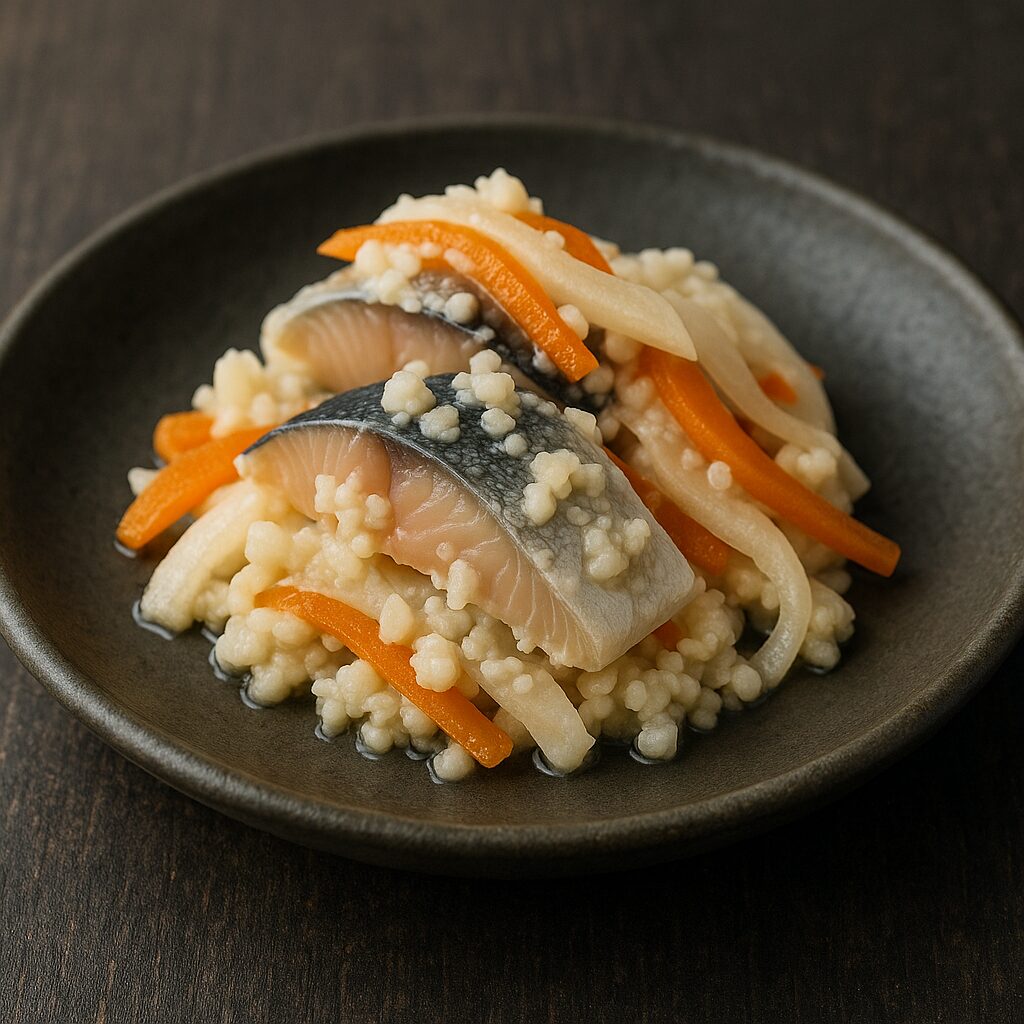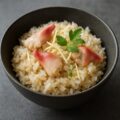飯鮨(いずし)の特徴
発酵食品としての独自性
飯鮨は北海道や東北地方に伝わる発酵寿司で、魚と米、野菜を発酵させて作る保存食です。乳酸発酵によって独特の酸味と旨味が生まれます。
冬の保存食
冷蔵技術がなかった時代、冬場の魚の保存方法として発達しました。特に北海道ではニシンや鮭を使ったものが有名です。
旨味と香り
魚のたんぱく質が分解され、アミノ酸が増えることで深い旨味が生まれ、独特の風味が楽しめます。
飯鮨のレシピ(簡易版)
材料(4人分)
- 生鮭(またはニシン、ホッケなど) … 400g
- 米飯 … 2合分
- 米麹 … 100g
- 人参、大根、キャベツ … 適量
- 塩 … 適量
- 酢 … 少量(発酵を安定させるため)
作り方(家庭向け簡易版)
- 魚を三枚におろし、塩を振って数時間〜一晩置き、水分を抜く。
- 野菜は千切りにして軽く塩をし、水気を絞る。
- 飯(炊きたての米)に米麹と酢を混ぜる。
- 容器に飯・魚・野菜を交互に重ねる。
- 重石をして冷暗所で1週間〜10日ほど発酵させる。
飯鮨の栄養価(1人分の目安)
- エネルギー:約250〜300 kcal
- たんぱく質:15〜20 g
- 脂質:5〜10 g(魚種により変動)
- 炭水化物:30〜40 g(飯由来)
- 乳酸菌:腸内環境を整える
- ビタミンB群:発酵過程で増加
発酵食品であり、腸内環境を整える効果が期待できます。ただし塩分が多いため食べ過ぎには注意が必要です。
飯鮨の歴史
発祥
室町時代には「熟れ鮨」として近畿地方で食べられていたが、北海道や東北では寒冷な気候に合わせて長期保存食として発展しました。
北海道での定着
江戸時代以降、北海道の漁村でニシンや鮭を使った飯鮨が盛んに作られるようになり、冬の食卓に欠かせない料理となりました。
現代
現在では保存食というよりも郷土料理・季節料理として親しまれ、特に正月料理の一つとして食べられています。
English Version
Features of Izushi (Fermented Sushi)
Unique Fermented Food
Izushi is a traditional fermented sushi from Hokkaido and Tohoku, made by fermenting fish, rice, and vegetables. The lactic acid fermentation creates a distinctive sourness and umami.
Winter Preservation Food
Before refrigeration, it developed as a method to preserve fish during winter. In Hokkaido, salmon and herring are especially famous ingredients.
Umami and Aroma
Proteins in the fish break down into amino acids, enhancing umami and giving the dish a unique aroma.
Recipe (Simplified)
Ingredients (for 4 servings)
- Fresh salmon (or herring, Atka mackerel) … 400g
- Cooked rice … 2 cups
- Rice malt (koji) … 100g
- Carrot, daikon, cabbage … appropriate amount
- Salt … to taste
- Vinegar … a little (to stabilize fermentation)
Instructions
- Fillet the fish, sprinkle with salt, and rest overnight to draw out moisture.
- Slice vegetables, salt lightly, and squeeze out excess water.
- Mix cooked rice with rice malt and vinegar.
- Layer rice, fish, and vegetables alternately in a container.
- Press with a weight and ferment in a cool place for 7–10 days.
Nutritional Value (per serving, approx.)
- Calories: 250–300 kcal
- Protein: 15–20 g
- Fat: 5–10 g (depends on fish)
- Carbohydrates: 30–40 g (from rice)
- Lactic acid bacteria: beneficial for gut health
- B vitamins: increased through fermentation
A probiotic-rich dish beneficial for digestion, but high in salt, so moderation is recommended.
Historical Background
Origin
In the Muromachi period, a similar style called “Narezushi” was eaten in the Kansai region. In Hokkaido and Tohoku, Izushi developed as a long-term preserved food adapted to the cold climate.
Establishment in Hokkaido
From the Edo period onward, herring and salmon-based Izushi became widespread in Hokkaido’s fishing villages, a staple of winter meals.
Modern Day
Today, Izushi is more of a seasonal or festive food, often eaten during New Year celebrations as a regional specialty.



何でも質問してください!